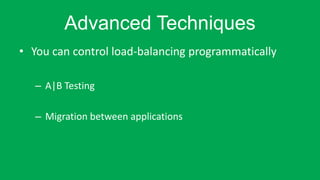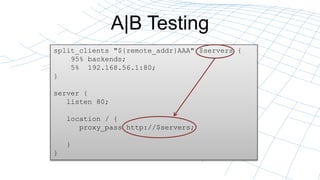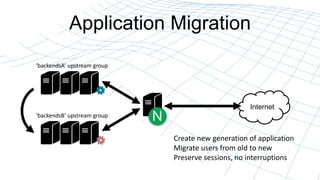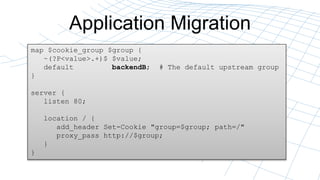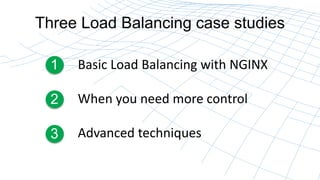load balancing for web servers and .pdf
- 1. Load Balancing and Scaling with NGINX Introduced by Andrew Alexeev Presented by Owen Garrett Nginx, Inc.
- 2. About this webinar When one server just isn°Øt enough, how can you scale out? In this webinar, you'll learn how to build out the capacity of your website. You'll see a variety of scalability approaches and some of the advanced capabilities of NGINX Plus.
- 4. What is NGINX? Internet N Web Server Serve content from disk Application Server FastCGI, uWSGI, Passenger°≠ Proxy Caching, Load Balancing°≠ HTTP traffic ?Application Acceleration ?SSL and SPDY termination ?Performance Monitoring ?High Availability Advanced Features: ?Bandwidth Management ?Content-based Routing ?Request Manipulation ?Response Rewriting ?Authentication ?Video Delivery ?Mail Proxy ?GeoLocation
- 6. 22% Top 1 million websites 37% Top 1,000 websites
- 7. NGINX and NGINX Plus NGINX F/OSS nginx.org 3rd party modules Large community of >100 modules
- 8. NGINX and NGINX Plus NGINX F/OSS nginx.org 3rd party modules Large community of >100 modules NGINX Plus Advanced load balancing features Ease-of-management Commercial support
- 10. Load-balancing Web Servers Internet N ? Improved Application Availability ? Management ? Increased Capacity ? Advanced techniques e.g. A|B testing Why? ? DNS Round Robin ? Hardware L4 load balancer ? Software Reverse Proxy LB ? Cloud solution How?
- 12. Three Load Balancing case studies Basic Load Balancing with NGINX When you need more control Advanced techniques 1 2 3
- 13. 1. Basic Load Balancing ? Simple scalability ®C All servers have same applications/services ®C Load-balancer extracts optimal performance
- 14. Basic load balancing server { listen 80; location / { proxy_pass http://backend; } } upstream backend { zone backend 64k; server webserver1:80; server webserver2:80; server webserver3:80; server webserver4:80; }
- 15. Basic load balancing ? Use logging to debug: °∞$upstream_addr°± log_format combined2 '$remote_addr - $remote_user [$time_local] ' '"$request" $status $body_bytes_sent ' '"$upstream_addr"'; 192.168.56.1 - - [09/Mar/2014:23:08:56 +0000] "GET / HTTP/1.1" 200 30 "127.0.1.1:80" 192.168.56.1 - - [09/Mar/2014:23:08:56 +0000] "GET /favicon1.ico HTTP/1.1" 200 30 "127.0.1.2:80" 192.168.56.1 - - [09/Mar/2014:23:08:57 +0000] "GET / HTTP/1.1" 200 30 "127.0.1.3:80" 192.168.56.1 - - [09/Mar/2014:23:08:57 +0000] "GET /favicon1.ico HTTP/1.1" 200 30 "127.0.1.4:80" 192.168.56.1 - - [09/Mar/2014:23:08:57 +0000] "GET / HTTP/1.1" 200 30 "127.0.1.1:80" 192.168.56.1 - - [09/Mar/2014:23:08:57 +0000] "GET /favicon1.ico HTTP/1.1" 200 30 "127.0.1.2:80" 192.168.56.1 - - [09/Mar/2014:23:08:58 +0000] "GET / HTTP/1.1" 200 30 "127.0.1.3:80" 192.168.56.1 - - [09/Mar/2014:23:08:58 +0000] "GET /favicon1.ico HTTP/1.1" 200 30 "127.0.1.4:80"
- 16. Basic Load Balancing ? Round-robin is the default ®C Suitable for consistent pages ? Least Connections ®C Suitable for varying pages ? IP Hash ®C Fixed mapping, basic session persistence upstream backend { server webserver1:80; server webserver2:80; } upstream backend { least_conn; server webserver1:80; server webserver2:80; } upstream backend { ip_hash; server webserver1:80; server webserver2:80; }
- 17. Managing the Upstream Group ? Direct config editing: ®C nginx ®Cs reload ®C upstream.conf file: ? On-the-fly Reconfiguration [NGINX Plus only] upstream backend { server webserver1:80; server webserver2:80; server webserver3:80; server webserver4:80; } $ curl 'http://localhost/upstream_conf?upstream=backend&id=3&down=1'
- 18. 2. When you need more control°≠ ? In many scenarios, you want more control over where traffic is routed to: ®C Primary and secondary servers (aka master/slave) ®C Transaction state is accumulated on one server
- 19. Internet °ÆMaster°Ø and °ÆSlave°Ø servers ? Wordpress admin traffic (e.g. image uploads) N °ÆMaster°Ø °ÆSlave°Ø Copy image uploads from master to slave
- 20. °ÆMaster°Ø and °ÆSlave°Ø servers ? Wordpress admin traffic (e.g. image uploads) N server { listen 80; location ~ ^/(wp-admin|wp-login) { proxy_pass http://wpadmin; } } upstream wpadmin { server server1:80; server server2:80 backup; } °ÆMaster°Ø °ÆSlave°Ø
- 21. Session Persistence [NGINX Plus only] ? For when transaction state is accumulated on one server ®C Shopping carts ®C Advanced interactions ®C Non-RESTful Applications ? NGINX Plus offers two methods: ®C sticky cookie ®C sticky route °∞Session persistence also helps performance°±
- 22. Advanced Techniques ? You can control load-balancing programmatically ®C A|B Testing ®C Migration between applications
- 23. A|B Testing Internet N °Æbackends°Ø upstream group Test server 95% 5% Partition traffic. Send 5% to new application instance
- 24. A|B Testing split_clients "${remote_addr}AAA" $servers { 95% backends; 5% 192.168.56.1:80; } server { listen 80; location / { proxy_pass http://$servers; } }
- 25. Application Migration Internet N °ÆbackendsA°Ø upstream group °ÆbackendsB°Ø upstream group Create new generation of application Migrate users from old to new Preserve sessions, no interruptions
- 26. Application Migration map $cookie_group $group { ~(?P<value>.+)$ $value; default backendB; # The default upstream group } server { listen 80; location / { add_header Set-Cookie "group=$group; path=/" proxy_pass http://$group; } }
- 27. Three Load Balancing case studies Basic Load Balancing with NGINX When you need more control Advanced techniques 1 2 3
- 28. Closing thoughts ? 37% of the busiest websites use NGINX ? Check out the load-balancing articles on nginx.com/blog ? Future webinars: nginx.com/webinars Try NGINX F/OSS (nginx.org) or NGINX Plus (nginx.com)

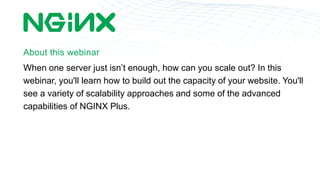

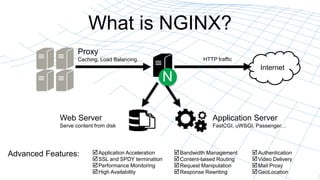


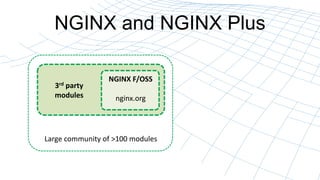
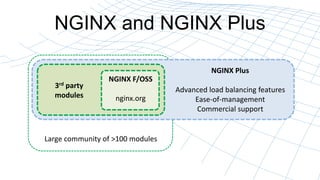



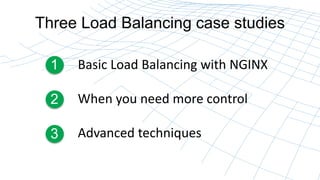
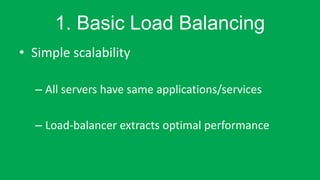
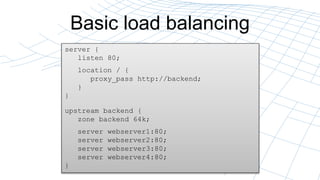
![Basic load balancing
? Use logging to debug: °∞$upstream_addr°±
log_format combined2 '$remote_addr - $remote_user [$time_local] '
'"$request" $status $body_bytes_sent '
'"$upstream_addr"';
192.168.56.1 - - [09/Mar/2014:23:08:56 +0000] "GET / HTTP/1.1" 200 30 "127.0.1.1:80"
192.168.56.1 - - [09/Mar/2014:23:08:56 +0000] "GET /favicon1.ico HTTP/1.1" 200 30 "127.0.1.2:80"
192.168.56.1 - - [09/Mar/2014:23:08:57 +0000] "GET / HTTP/1.1" 200 30 "127.0.1.3:80"
192.168.56.1 - - [09/Mar/2014:23:08:57 +0000] "GET /favicon1.ico HTTP/1.1" 200 30 "127.0.1.4:80"
192.168.56.1 - - [09/Mar/2014:23:08:57 +0000] "GET / HTTP/1.1" 200 30 "127.0.1.1:80"
192.168.56.1 - - [09/Mar/2014:23:08:57 +0000] "GET /favicon1.ico HTTP/1.1" 200 30 "127.0.1.2:80"
192.168.56.1 - - [09/Mar/2014:23:08:58 +0000] "GET / HTTP/1.1" 200 30 "127.0.1.3:80"
192.168.56.1 - - [09/Mar/2014:23:08:58 +0000] "GET /favicon1.ico HTTP/1.1" 200 30 "127.0.1.4:80"](https://image.slidesharecdn.com/load-250314105716-4e58d022/85/load-balancing-for-web-servers-and-pdf-15-320.jpg)
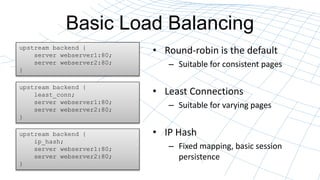
![Managing the Upstream Group
? Direct config editing:
®C nginx ®Cs reload
®C upstream.conf file:
? On-the-fly Reconfiguration [NGINX Plus only]
upstream backend {
server webserver1:80;
server webserver2:80;
server webserver3:80;
server webserver4:80;
}
$ curl 'http://localhost/upstream_conf?upstream=backend&id=3&down=1'](https://image.slidesharecdn.com/load-250314105716-4e58d022/85/load-balancing-for-web-servers-and-pdf-17-320.jpg)


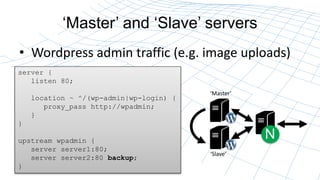
![Session Persistence [NGINX Plus only]
? For when transaction state is accumulated on one server
®C Shopping carts
®C Advanced interactions
®C Non-RESTful Applications
? NGINX Plus offers two methods:
®C sticky cookie
®C sticky route
°∞Session persistence also
helps performance°±](https://image.slidesharecdn.com/load-250314105716-4e58d022/85/load-balancing-for-web-servers-and-pdf-21-320.jpg)
